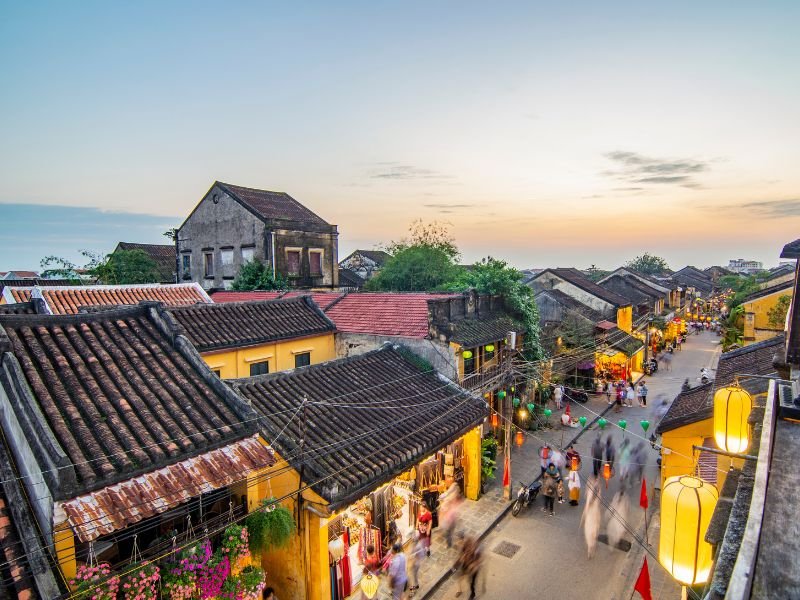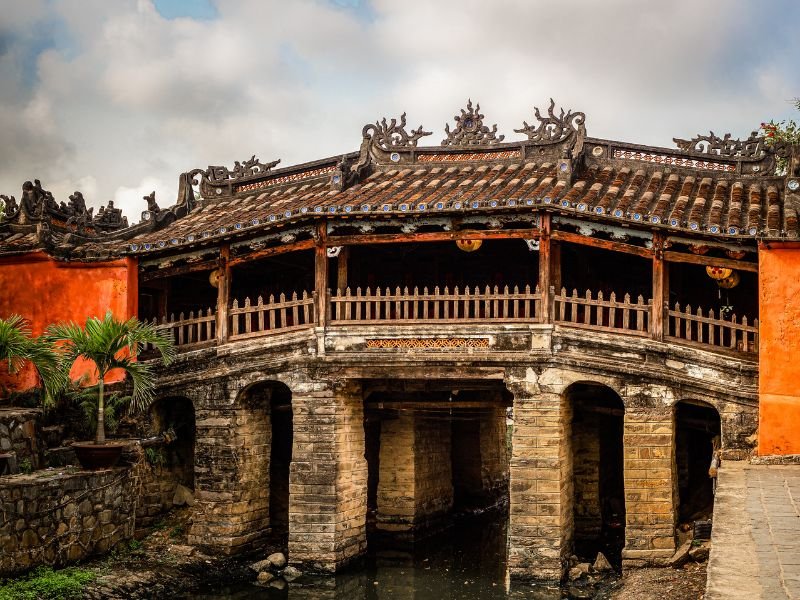Hoi An Ancient Town, situated in Quang Nam Province, Vietnam, is a remarkably preserved Southeast Asian trading port dating from the 15th to 19th centuries. Recognized as a UNESCO World Heritage site, it is renowned for its well-maintained architecture, historical significance, and dynamic cultural landscape. The town is positioned along the Thu Bon River and historically served as a major commercial hub, attracting merchants from China, Japan, and Europe.
In contemporary times, Hoi An has become a prominent tourist destination, drawing international visitors eager to explore its quaint streets, historic structures, and distinctive cultural heritage. Often described as a living museum, Hoi An provides insight into Vietnam’s rich historical and cultural legacy. The town’s compact streets are flanked by traditional wooden dwellings, Chinese temples, and former tea warehouses, creating a visually captivating and atmospheric environment.

Hoi An in Central Vietnam
Visitors can explore numerous historic landmarks, including the iconic Japanese Covered Bridge, Quan Cong Temple, and Phuc Kien Assembly Hall. Beyond its historical importance, Hoi An is celebrated for its thriving arts and crafts community, where local artisans practice traditional techniques such as silk weaving, lantern crafting, and pottery. The town’s unique combination of historical significance, cultural richness, and artisanal craftsmanship offers visitors an immersive and memorable experience. When planning a trip you can create an amzing Central Vietnam Itinerary to get the best of you Vietnam holiday.
Key Takeaways
- Hoi An Ancient Town is a charming and well-preserved UNESCO World Heritage site in Vietnam, known for its rich history, culture, and architecture.
- Hoi An has a fascinating history as a major trading port, blending influences from various cultures including Chinese, Japanese, and European, making it a melting pot of traditions and customs.
- The architecture and design of Hoi An reflect its diverse cultural influences, with well-preserved ancient houses, assembly halls, and pagodas that showcase the town’s unique blend of styles.
- Hoi An is a paradise for food lovers, offering a wide range of culinary delights such as Cao Lau, White Rose, and Banh Mi, as well as cooking classes and food tours for visitors to experience the local cuisine.
- Visitors to Hoi An can indulge in shopping for unique handicrafts, silk products, and tailor-made clothing, as well as exploring the vibrant night market and lantern-lit streets.
The History and Cultural Significance of Hoi An
A Golden Age of Trade
During the 16th and 17th centuries, Hoi An, then known as Faifo, reached its peak as one of the most important trading ports in Southeast Asia. However, as maritime trade routes shifted and the Thu Bon River silted up, Hoi An’s importance declined, preserving it as a well-preserved example of an ancient trading port.
A Unique Architectural Style
Today, Hoi An’s cultural significance is evident in its well-preserved architecture, which reflects the town’s multicultural heritage. The town’s historic buildings feature a unique blend of Chinese, Japanese, Vietnamese, and European influences, creating a distinctive architectural style that is unlike anywhere else in Vietnam.
Traditional Customs and Festivals
In addition to its architectural significance, Hoi An is also known for its traditional customs and festivals, which have been passed down through generations. The town’s annual lantern festival, held on the 14th day of each lunar month, is a highlight for visitors and locals alike, featuring colorful lanterns, traditional music and dance performances, and vibrant street parades.
Exploring the Architecture and Design of Hoi An

Hoi An’s architecture is a testament to its rich history and multicultural heritage. The town’s historic buildings feature a unique blend of Chinese, Japanese, Vietnamese, and European influences, creating a distinctive architectural style that is unlike anywhere else in Vietnam. One of the most iconic examples of Hoi An’s architecture is the Japanese Covered Bridge, which was built in the 16th century by Japanese merchants to connect the Japanese community with the Chinese quarter.

The bridge is adorned with intricate carvings and statues of monkeys and dogs, which are believed to have been built during the years of the monkey and dog in the Chinese zodiac. Another notable example of Hoi An’s architecture is the Quan Cong Temple, dedicated to the Chinese general Quan Cong and featuring ornate carvings and colorful statues. In addition to its historic buildings, Hoi An is also known for its traditional wooden houses, which line the town’s narrow streets.

Quan Cong Temple Hoi An
These houses feature intricate carvings, colorful shutters, and tiled roofs, creating a charming and atmospheric setting. Many of these houses have been preserved as museums or guesthouses, allowing visitors to step back in time and experience life in ancient Hoi An. With its unique blend of architectural styles and well-preserved buildings, Hoi An offers a fascinating insight into Vietnam’s multicultural heritage and historical significance.
The Culinary Delights of Hoi An
| Delight | Description |
|---|---|
| Cao Lau | A regional Vietnamese dish made with noodles, pork, and local greens |
| White Rose Dumplings | Shrimp-filled dumplings unique to Hoi An |
| Banh Mi | A Vietnamese sandwich with various fillings |
| Com Ga | Hoi An’s version of chicken rice, a local specialty |
Hoi An is renowned for its delicious cuisine, which reflects the town’s multicultural heritage and vibrant food culture. The town’s culinary scene is characterized by fresh seafood, aromatic herbs and spices, and a wide variety of dishes influenced by Chinese, Japanese, Vietnamese, and European traditions. One of Hoi An’s most famous dishes is cao lau, a noodle dish made with thick rice noodles, tender slices of pork, fresh herbs, and crispy croutons.

Cao Lau
Cao lau is believed to have been created by Chinese traders who settled in Hoi An during the 17th century and is only made with water from a specific well in the town. Another popular dish in Hoi An is white rose dumplings, delicate shrimp-filled dumplings that are steamed and topped with crispy shallots and tangy dipping sauce. These dumplings are a specialty of Hoi An and are made using a secret recipe that has been passed down through generations.
In addition to its savory dishes, Hoi An is also known for its sweet treats, including banh bao banh vac (steamed rice cakes filled with shrimp or pork) and che (sweet soups made with coconut milk, fruit, and beans). With its diverse culinary offerings and vibrant food culture, Hoi An is a paradise for food lovers and offers a truly unforgettable dining experience.
Shopping and Handicrafts in Hoi An
Hoi An is a shopper’s paradise, offering a wide variety of unique handicrafts, textiles, and souvenirs that reflect the town’s rich cultural heritage. One of Hoi An’s most famous products is its silk lanterns, which are handcrafted by local artisans using traditional techniques. These colorful lanterns are a symbol of Hoi An and can be found adorning the town’s streets, shops, and restaurants.
Visitors can also purchase their own lanterns to take home as a beautiful memento of their time in Hoi An. In addition to its silk lanterns, Hoi An is also known for its traditional textiles, including silk scarves, ao dai (traditional Vietnamese dresses), and hand-embroidered fabrics. Many shops in Hoi An offer custom tailoring services, allowing visitors to have their own garments made to measure using high-quality fabrics and skilled craftsmanship.
The town is also home to numerous art galleries and craft workshops where visitors can watch local artisans at work and purchase unique handmade items such as pottery, wood carvings, and lacquerware. With its vibrant arts and crafts scene and wide variety of unique products, Hoi An offers an unparalleled shopping experience for visitors.
Experiencing the Festivals and Traditions of Hoi An

Lanterns in Hoi An
Festivals and Celebrations
One of the most iconic festivals in Hoi An is the lantern festival, held on the 14th day of each lunar month. The town’s streets come alive with colorful lanterns, traditional music, and locals releasing floating lanterns onto the Thu Bon River as offerings for good luck. The festival also features traditional music and dance performances, vibrant street parades, and delicious food stalls serving local delicacies.
Ancestor Worship and Cultural Heritage
Ancestor worship is an integral part of Hoi An’s cultural life, with many families maintaining ancestral altars in their homes where they pay respects to their ancestors through offerings of food, incense, and prayers. Visitors can learn more about this tradition by visiting one of Hoi An’s many historic houses or temples that are open to the public.
Traditional Crafts and Workshops
Hoi An is also renowned for its traditional crafts, including silk weaving, lantern making, and pottery. Visitors can participate in workshops or demonstrations to learn more about these ancient techniques and create their own handmade souvenirs to take home. With its rich cultural traditions and vibrant festivals, Hoi An offers a truly immersive experience for visitors.
Tips for Visiting Hoi An
When visiting Hoi An Ancient Town, there are several tips to keep in mind to make the most of your experience. Firstly, it’s important to respect the town’s cultural heritage by dressing modestly when visiting temples or historic sites. This means covering your shoulders and knees out of respect for local customs.
Additionally, visitors should be mindful of their impact on the environment by avoiding single-use plastics and supporting eco-friendly businesses. Another tip for visiting Hoi An is to explore the town on foot or by bicycle to fully appreciate its charming streets and historic buildings. Many of Hoi An’s attractions are within walking distance of each other, making it easy to navigate on foot.
Visitors can also take a leisurely bike ride through the surrounding countryside to discover hidden gems such as rice paddies, water buffalo, and traditional villages. Finally, visitors should take advantage of Hoi An’s vibrant food scene by sampling local dishes at street food stalls or family-owned restaurants. This allows visitors to experience authentic Vietnamese cuisine while supporting local businesses.
By following these tips for visiting Hoi An Ancient Town, visitors can make the most of their time in this enchanting destination while respecting its cultural heritage and traditions.
FAQs
What is Hoi An Ancient Town?
Hoi An Ancient Town is a well-preserved example of a Southeast Asian trading port dating from the 15th to the 19th century. It is located in central Vietnam and is a UNESCO World Heritage site.
What are the main attractions in Hoi An Ancient Town?
Some of the main attractions in Hoi An Ancient Town include the Japanese Covered Bridge, the Assembly Hall of the Fujian Chinese Congregation, the Tan Ky Old House, and the Hoi An Museum.
What is the significance of Hoi An Ancient Town?
Hoi An Ancient Town was an important trading port in Southeast Asia during the 15th to 19th centuries. It was a melting pot of different cultures and is known for its well-preserved architecture and historical significance.
What is the best time to visit Hoi An Ancient Town?
The best time to visit Hoi An Ancient Town is during the dry season, which is from February to August. The weather is pleasant, and there are various cultural events and festivals during this time.
How do I get to Hoi An Ancient Town?
The nearest airport to Hoi An Ancient Town is Da Nang International Airport, which is about 30 kilometers away. From there, you can take a taxi or a shuttle bus to Hoi An. There are also buses and trains available from other major cities in Vietnam.


Leave a Reply